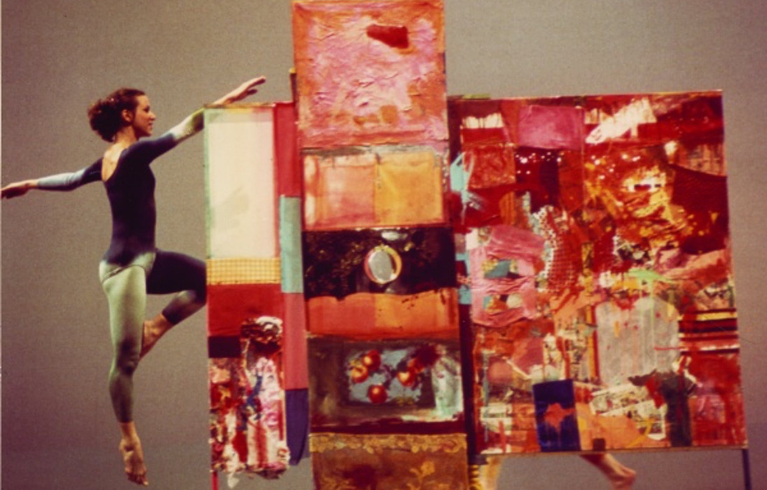Modern Artist Robert Rauschenberg - “I’m for yes..”
Photo by Maurice Hogenboom courtesy of the Robert Rauschenberg Foundation rauschenbergfoundation.org
A master collaborator, Robert Rauschenberg explored co-creation with other artists and his lovers, between various media and techniques - notably in his Combines, which blended and incorporated various found objects into three dimensional collage sculptures, and when bringing the wide, wild world outside of art galleries, into them.
Photo courtesy of the Robert Rauschenberg Foundation rauschenbergfoundation.org
Photo courtesy of the Robert Rauschenberg Foundation rauschenbergfoundation.org
There seem to have been no boundaries for Rauschenberg as an artist, or in what he considered to be art and artistic material. His work included lighting design, stage design, choreography, photography, screen printing, collaging, printmaking, sculpture, painting, and printing on fabrics and metals. He was fascinated with the relationship between art and technology, and created EAT, Experiments in Art and Technology, that brought artists, engineers, and scientists together to share their ideas. Here, Rauschenberg works at his studio in New York City with engineer Billy Klüver on the piece Oracle.
Photo courtesy of the Robert Rauschenberg Foundation rauschenbergfoundation.org
Rauschenberg met his wife, artist Susan Weil at the Académie Julian in Paris, and together they enrolled at Black Mountain College in North Carolina, where they studied under Bauhaus’ Josef Albers. Black Mountain was an experimental arts campus with an environment that fostered cross-disciplinary collaboration and the exchange of ideas between its students, much in the Bauhaus tradition. While there, Weil introduced Rauschenberg to photograms, which they began making together, creating x-ray like portraits of one another’s bodies, using photo sensitive paper that captured this ethereal and fleeting moment of their marriage. Their union didn’t last, but they had a son and maintained a lifelong friendship.
Photo courtesy of the Robert Rauschenberg Foundation rauschenbergfoundation.org
Rauschenberg’s artistic collaborations and friendships were often one and the same, as a 2015 New York Times article put it, for Rauschenberg, making art “.. was to a remarkable degree, an extension of friendship.” While still at Black Mountain College, in 1951, Rauschenberg and his artist friends and collaborators applied layers of white paint to canvases, creating “White Paintings”, which could be seen critically as just completely blank canvases, but which were actually backdrops for the shadows and light of time’s passing. This revolutionary piece of art inspired Rauschenberg’s friend and composer, John Cage, to create 4’33”, a four minute and thirty three second piece with no sound, except for the ambient noises that arose during its performance.
Photo courtesy of the Robert Rauschenberg Foundation rauschenbergfoundation.org
Traveling the world together with his then lover, fellow artist Cy Twombly, in 1952-1953, Rauschenberg and Twombly collaborated in their exploration of places, self, and art form. Their travels through Italy and North Africa on Twombly’s artists grant resulted in Rauschenberg’s creation of ‘Feticcio Personale’ - personal fetishes, and Twombly’s experimentation with what would become his signature style.
Photo courtesy of the Robert Rauschenberg Foundation rauschenbergfoundation.org
1953’s collaboration with the more famous and more established artist at the time, Willem de Kooning, saw the two artists meet on the very grounds of a de Kooning canvas. Rauschenberg asked for a piece of de Kooning’s art so that he could erase it, and de Kooning obliged, giving Rauschenberg a piece of art that he said he knew he would miss, imbuing the exchange with the bittersweetness of impermanence. Ultimately, the “Erased de Kooning Drawing” was never quite fully erased, ghosts of de Kooning’s original artwork remained visible. Some saw this act as an affront, assuming Rauschenberg to be an audacious upstart, trampling on a highly celebrated artist’s work, but de Kooning was an accomplice, agreeing to the concept and willingly playing a part in the performance, and Rauschenberg called the act “..not a negation.. [but] .. a celebration.”
Photo courtesy of the San Francisco Museum of Modern Art SFMOMA via artsy.net
Photo courtesy of the San Francisco Museum of Modern Art SFMOMA via artsy.net
Rauschenberg’s long and fruitful collaboration with his friend Merce Cunningham (John Cage’s partner), resulted in avant-garde, experimental costumes, sets, and lighting designs made for Cunningham’s dance company. Often little guidance was provided, so Rauschenberg’s costumes were as innovative and inventive as the choreography, and his lighting designs eclectically electric, sometimes momentarily obscuring the performance onstage, or having very little at all to do with it, or even at times blinding the audience. Their collaboration seemed to be based in a respect for the other’s interpretation, and the stage was the platform where their individual artistic visions could meet, play, collide, and be discovered, in real time.
Photo courtesy of the New York Times nytimes.com
Photo courtesy of the Robert Rauschenberg Foundation rauschenbergfoundation.org
Cunningham welcomed Rauschenberg’s vision, sometimes using the Combine sculptures as stage sets that his choreography could weave dancers around. When on tour, if it was not possible to find local objects to create on-site Combines, Rauschenberg innovated “live décor” or “living sets”. These included someone sweeping the stage during a show, and Rauschenberg himself sitting and painting amongst the dancers during a performance of Homage to David Tudor, at the American Embassy in Paris. Rauschenberg later designed sets and costumes for the dance companies of Trisha Brown and Paul Taylor, students of Merce Cunningham, in further successful collaborations.
Photo courtesy of museemusings.com
Rauschenberg’s iconic piece “Signs”, from 1970, is a collaboration of materials and techniques, as he combined photography, collage, and screen printing to create a layered visual that captured the wild energy of the era. Images of Janis Joplin, John and Bobby Kennedy, Martin Luther King Jr., Buzz Aldrin, the Vietnam War, and racist violence overlap and rise up on a canvas that is part Pop Art, part memorial. The piece was originally to be a magazine cover, but was considered too bold, and so was passed over, and instead, “Signs” became an iconic and celebrated piece of art.
Photo courtesy of the Robert Rauschenberg Foundation rauschenbergfoundation.org
In 1970 Rauschenberg moved to Captiva, an island off of Florida, where he lived for the rest of his life, continuing his artistic explorations, output, and collaborations.
Photo courtesy of mag.citizensofhumanity.com
He installed a print workshop there, a lithography press, and an etching press, and continued screen printing and experimenting with new materials, including fabrics and cardboard.
Photo courtesy of the Robert Rauschenberg Foundation rauschenbergfoundation.org
Photo courtesy of the Robert Rauschenberg Foundation rauschenbergfoundation.org
On Captiva the environment of the world around him continued to inform his creations, and in order to preserve the beauty of the landscape, Rauschenberg purchased the properties surrounding his own, eventually expanding his artist’s compound to encompass 20 acres. He bought the properties of his neighbors, but allowed them to continue living in them until the end of their lives, as the point was just to conserve the environment that he loved and wished to protect against development. His collaborations in this case were with the community and landscape around him. Nothing was too small or too large to be important. As reported in the Guardian in 2016, Rauschenberg once said, “I’m for yes.. No excludes. I’m for inclusion..”
Photo courtesy of the Robert Rauschenberg Foundation rauschenbergfoundation.org
Photo via coralmorphologic.com
This spirit of brilliant curiosity, enthusiasm for art and life, and a willingness to collaborate and explore continues today on Captiva with artist residencies happening at Rauschenberg’s former home. Supported by the Robert Rauschenberg Foundation, his studios have become an interdisciplinary retreat for artists that much resembles his early collaborative days at Black Mountain College. His print studio and printing equipment continue to be used, while one building has been transformed into a dance studio, another into a writing retreat, and still yet another into a full kitchen, where visiting chefs in residence create communal meals for the visiting guests. Those once neighboring houses have become residences, and a dark room, welding equipment, digital printer, and kiln have been added.
Photo courtesy of the Robert Rauschenberg Foundation rauschenbergfoundation.org
Photo courtesy of the Robert Rauschenberg Foundation rauschenbergfoundation.org
Robert Rauschenberg was a generous, well-liked man, with a groundbreaking and unique creativity. He continued to create art and live a life surrounded by friends, partners, and collaborators until his death at 82 years old, in his studio at home on Captiva.
Photo by Ed Chappell courtesy of the Robert Rauschenberg Foundation rauschenbergfoundation.org
Photo courtesy of the Robert Rauschenberg Foundation rauschenbergfoundation.org
Images courtesy of the Robert Rauschenberg Foundation, the San Francisco Museum of Modern Art SFMOMA, NY Times nytimes.com, Artsy.net, Maurice Hogenboom, Ed Chappell, coralmorphologic.com, mag.citizensofhumanity.com, and museemusings.com.






















